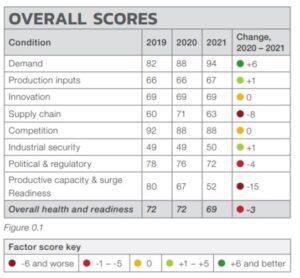
America’s defense industrial base has seen better days. (Lockheed Martin)
WASHINGTON: The health of the defense industrial base has received a “failing” grade from a lead defense trade group for the first time, largely due to unprecedented and ongoing challenges created by the COVID-19 pandemic and strategic competition from China and Russia.
That conclusion is part of the National Defense Industrial Association’s third annual Vital Signs 2022 report, which offers an analysis of the US’s defense industrial base. For this year’s report, NDIA and data firm Govini worked together to grade eight “vital signs” that shape the performance of defense contractors, on a 0 to 100 scale, where an average score of 70 is considered passing.
Of the eight categories — demand; production inputs; innovation; supply chain; competition; industrial security; political and regulatory; and productive capacity and surge readiness —five received a “failing” grade.
“This past year has witnessed significant deterioration in the signs including ‘supply chain’ as well as ‘production capacity and surge readiness,’ which almost certainly is a result of the impact of the pandemic,” according to the report. “Conversely, the only sign that significantly improved was ‘demand,’ reflecting recent growth in the defense budget.”
“Industrial security” continues to be the weakest sign in NDIA report, receiving an overall failing score of 50. The score reflects larger trends in shortcomings of industrial cybersecurity, despite increasing resources dedicated to combating the threat, the report states. The number of newly reported common IT cybersecurity vulnerabilities continued to increase.
“Data breaches, intellectual property theft, and state-sponsored industrial espionage in both private companies and university labs are on an unrelenting rise while the dynamic nature of attacks makes it a constantly moving target to address,” according to the report.

NDIA is worried about the health of the defense industrial base.
Industrial security has also been an area of active federal rulemaking, the report states, pointing to the Cybersecurity Maturity Model Certification as a prime example.
An Interim Rule for CMMC was released in 2020, “prohibiting executive agencies from entering into contracts with any entity that incorporates any equipment or service that uses telecommunication equipment made by Huawei, ZTE, and several other Chinese-made telecommunications equipment manufacturers,” according to the report. “CMMC is a DOD effort to improve the handling of sensitive information by and within the defense industrial base . . . These programs are still in interim stages and their impact on cybersecurity is yet to be determined.”
RELATED: Pentagon Rolls Out V2.0 Of Controversial CMMC Program
Innovation also remained stagnant last year, with a decline in investments and a lack of change in the status of scientific research and development services, according to the report. NDIA gave this area a score of 69 for 2021, the same score it received in 2020.
The need for US technological dominance is bolstered by the growing intensity of competition with China and Russia. According to the report, R&D investment has declined precipitously as a percentage of global expenditures. As of 1995 the US ranked fourth in terms of total R&D expenditures as a percentage of GDP and by 2019, it dipped to tenth.
“Outside of the private sector, public sector investment in innovation also continued to deteriorate,” according to the report. “This is especially significant considering that public sector funding dominates the area of basic, experimental and theoretical research in the U.S. Between 2011 and 2016, U.S. government funding for R&D projects fell by 12% in absolute terms. Over the same timeframe, Russia and China grew public investment in R&D by 13% and 56%, respectively.”
The outlook for innovation continues to remain bleak: According to the report, companies this year will be required to amortize their R&D expenses over five years as part of the Tax Cuts and Jobs Act of 2017, amounting to a significant tax increase, negatively impacting innovation.
This year’s report includes a new section: emerging technologies. NDIA’s Emerging Technologies Institute says some uncertainty lies ahead for the future of emerging technologies and the US needs to prioritize defense modernization above all else.
RELATED: New NDIA Spin-Off Focuses On Building Next-Gen Tech Base For DoD
“The 2018 National Defense Strategy placed a heavy emphasis on investing in high-end technologies to improve overall capability,” the report states. “The question now is whether the 2022 NDS will do the same. Though we are still in a transition period, indications are that the Biden administration will make relatively few changes in modernization priorities. DoD leaders have states that integrated deterrence will play a large part in the new defense strategy, which will require technological improvement across all agencies and services.”
Despite the negative scores, the report does point to a few areas of confidence. For example, the demand for defense goods and services remained robust in 2021 due to a rise in contract obligations issued by DoD.
Another area that NDIA considered passing was competition, with an analysis of the top 100 publicly-traded DoD contractors producing favorable outcomes.
“This high mark was driven by several high-scoring factors including a low level of market concentration for total contract awards, the low share of total contract awards received by foreign contractors, and a high level of capital expenditure in the DIB,” the report states. “Conversely, other factors within the ‘competition’ sign experienced decreases, including a significant 11-point decrease for liquidity. These decreases were anticipated, however, due to the impact of the pandemic on the economy.”
‘Poisoned’ data could wreck AIs in wartime, warns Army software acquisition chief
“Any commercial LLM that is out there, that is learning from the internet, is poisoned today,” Jennifer Swanson said, “but our main concern [is] those algorithms that are going to be informing battlefield decisions.”


























